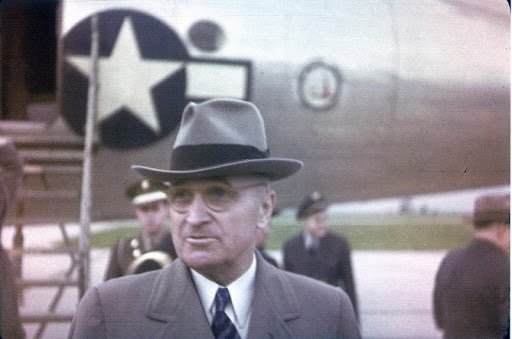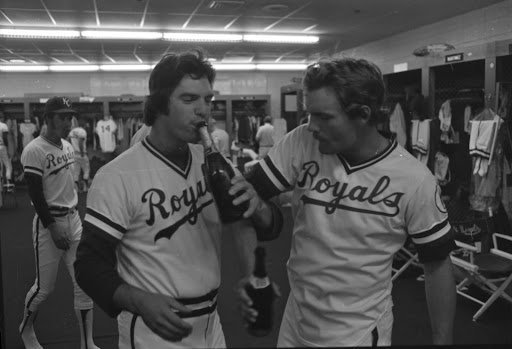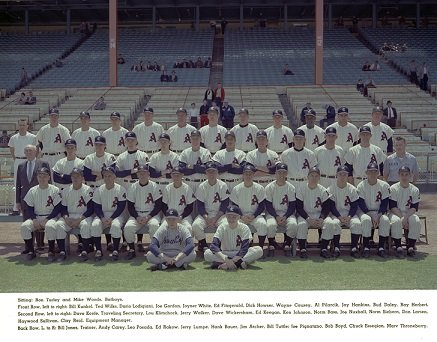Kansas City’s History in Photos
For the past several months Erin Gray, digital archivist for the Jackson County Historical Society, has been tasked with processing the vast Wilborn Collection of archival images. Steve Noll, former Society executive director, with his wife Marianne, donated the collection to the Society in 2017.
In our April E-Journal, Erin describes just what this involves.
By Erin Gray
President Truman (as seen here in either 1945 or 1946) helped make air travel routine for US Presidents.
2017.006.4773c
The Wilborn Collection of negatives and photographs is the largest collection in the United States focused specifically on Jackson County.
The collection’s approximately 300,000 images or more – the exact number is still uncertain - document a wide array of different historical events, captured in black and white and, occasionally, in color.
When the collection arrived at the historical society, we were told that it spanned the years from 1920 through 2007. We are excited to say it covers a few more years than that. Recently research has confirmed several panoramic negatives dating back even further. The oldest so far shows the official opening of Union Station on October 30th, 1914.
We are also researching a negative of an American soldier in World War I attire. We believe this picture was taken some time during the war, although we have not yet confirmed this information.
In processing other Wilborn photos we have found images that document Kansas City airport operation over the years – just as work on the new single terminal facility Kansas City International Airport nears completion.
It now being baseball season, we’ve been pleased to find images from Kansas City’s hardball past. They include a team photo of the Kansas City Athletics from 1961 as well as a shot of Kansas City Royals slugger George Brett celebrating with a teammate and a bottle of champagne after a big win in 1977.
George Brett with champagne, possibly celebrating division title, 1977
2017.006.5255d
These are but a few of the moments that make up Jackson County’s history that we are excited to finally be able to share with the public.
It took some time to decide how best to share this collection with our members; such a large collection would need to be cataloged and organized properly before we could even begin to open it to the public.
An additional step we wanted to take, to make the viewing of this collection easier, was to digitize each individual image and include it in our Digital History Database, which can be found on our website at http://jchs.catalogaccess.com.
Kansas City A’s team portrait, 1961
2017.006.111
Digitizing at first seems like such an easy process. The fastest way to do it with a traditional paper document is by using an automatic feeder - just tuck something in the feeder and you’re off.
For the sometimes-fragile negatives and photographs comprise much of the Wilborn Collection, this is not something we even would consider. Each item is far too fragile to risk a jam in a paper feeder.
So then, how do we do it?
Manual scanning is required for each and every piece of the collection - all 300,000 or more pieces of it. For each image there are several steps to take before it is available to be viewed in our online database.
The images are various sizes. Some are as small as an individual image on a single roll of film similar to what would have been used by a consumer-grade Kodak camera decades ago.
Whitaker Battery Supply Company, open from 1928 to 1946
2017.006.4195
Others are large panoramic photos, measuring anywhere from 18” to 24” across. The ability to scan all items in this collection, from the smallest negative to the largest panoramic, was made possible by the many generous financial donations to the Jackson County Historical Society’s Wilborn Collection fund. The donations received last year allowed the Society to purchase a new Epson Graphics Arts scanner that is capable of not only managing the largest negatives but also is capable of providing the high-quality scans necessary to share them with the public.
Each image must also be carefully cataloged in our system to ensure that our records are accurate.
Sometimes – either in the margins of a negative or on the back of a photograph – there will be information written by the original photographer. The name or location may be noted and – if we are lucky – the date the photograph was taken.
Liberty Memorial Ceremony, 1962
20017.006.3403c
Many negatives we work with do not include this information, so our archivists then have more research to do.
After an image has been properly scanned and recorded, our museum software comes into play. Each item, description, and date is added to this software, allowing us to place the information in our database. So far, 214 images from the Wilborn Collection are included in our database.
Only then is the image finally searchable for all users.
We estimate that every image in the Wilborn Collection costs about $1.50 to digitize. This is why donations to the Wilborn Collection are so appreciated.
They allow the Society to continue its work of digitizing the county’s rich history of images and making them accessible to everyone through our online database. Anyone interested in furthering the work being done with the Wilborn Collection is invited to go to jchs.org/donate-index-impact and add “Wilborn Collection” in the comments along with your donation.
The Society thanks everyone who wants to work alongside us as we preserve the Wilborn Collection and make it available for generations to come.
Erin Gray, Digital Archivist







